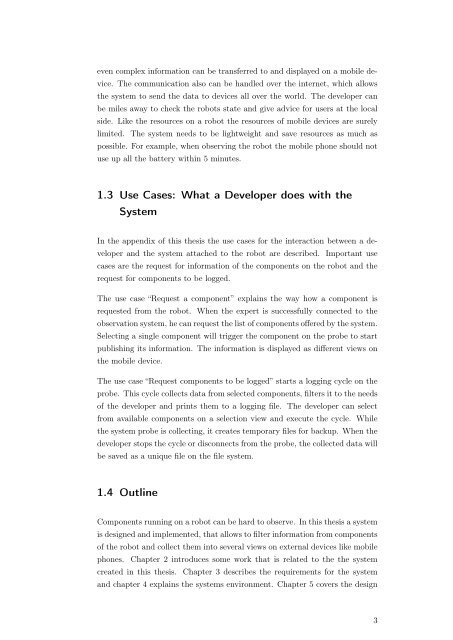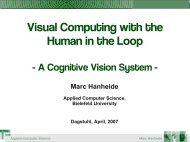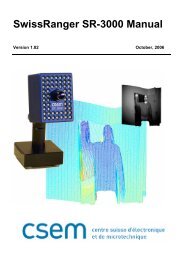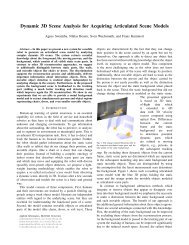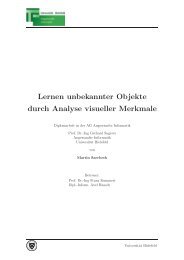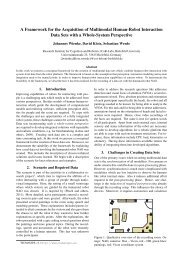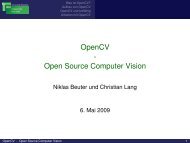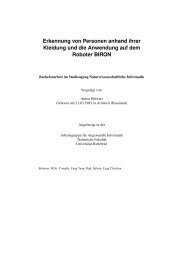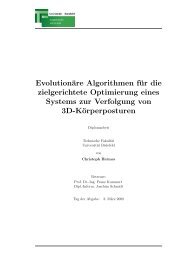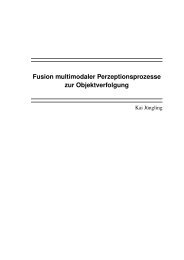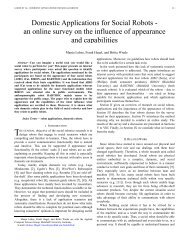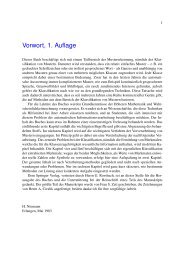System Introspection for System Analysis on Mobile Devices
System Introspection for System Analysis on Mobile Devices
System Introspection for System Analysis on Mobile Devices
You also want an ePaper? Increase the reach of your titles
YUMPU automatically turns print PDFs into web optimized ePapers that Google loves.
even complex in<str<strong>on</strong>g>for</str<strong>on</strong>g>mati<strong>on</strong> can be transferred to and displayed <strong>on</strong> a mobile device.The communicati<strong>on</strong> also can be handled over the internet, which allowsthe system to send the data to devices all over the world. The developer canbe miles away to check the robots state and give advice <str<strong>on</strong>g>for</str<strong>on</strong>g> users at the localside. Like the resources <strong>on</strong> a robot the resources of mobile devices are surelylimited. The system needs to be lightweight and save resources as much aspossible. For example, when observing the robot the mobile ph<strong>on</strong>e should notuse up all the battery within 5 minutes.1.3 Use Cases: What a Developer does with the<str<strong>on</strong>g>System</str<strong>on</strong>g>In the appendix of this thesis the use cases <str<strong>on</strong>g>for</str<strong>on</strong>g> the interacti<strong>on</strong> between a developerand the system attached to the robot are described. Important usecases are the request <str<strong>on</strong>g>for</str<strong>on</strong>g> in<str<strong>on</strong>g>for</str<strong>on</strong>g>mati<strong>on</strong> of the comp<strong>on</strong>ents <strong>on</strong> the robot and therequest <str<strong>on</strong>g>for</str<strong>on</strong>g> comp<strong>on</strong>ents to be logged.The use case “Request a comp<strong>on</strong>ent” explains the way how a comp<strong>on</strong>ent isrequested from the robot. When the expert is successfully c<strong>on</strong>nected to theobservati<strong>on</strong> system, he can request the list of comp<strong>on</strong>ents offered by the system.Selecting a single comp<strong>on</strong>ent will trigger the comp<strong>on</strong>ent <strong>on</strong> the probe to startpublishing its in<str<strong>on</strong>g>for</str<strong>on</strong>g>mati<strong>on</strong>. The in<str<strong>on</strong>g>for</str<strong>on</strong>g>mati<strong>on</strong> is displayed as different views <strong>on</strong>the mobile device.The use case “Request comp<strong>on</strong>ents to be logged” starts a logging cycle <strong>on</strong> theprobe. This cycle collects data from selected comp<strong>on</strong>ents, filters it to the needsof the developer and prints them to a logging file. The developer can selectfrom available comp<strong>on</strong>ents <strong>on</strong> a selecti<strong>on</strong> view and execute the cycle. Whilethe system probe is collecting, it creates temporary files <str<strong>on</strong>g>for</str<strong>on</strong>g> backup. When thedeveloper stops the cycle or disc<strong>on</strong>nects from the probe, the collected data willbe saved as a unique file <strong>on</strong> the file system.1.4 OutlineComp<strong>on</strong>ents running <strong>on</strong> a robot can be hard to observe. In this thesis a systemis designed and implemented, that allows to filter in<str<strong>on</strong>g>for</str<strong>on</strong>g>mati<strong>on</strong> from comp<strong>on</strong>entsof the robot and collect them into several views <strong>on</strong> external devices like mobileph<strong>on</strong>es. Chapter 2 introduces some work that is related to the the systemcreated in this thesis. Chapter 3 describes the requirements <str<strong>on</strong>g>for</str<strong>on</strong>g> the systemand chapter 4 explains the systems envir<strong>on</strong>ment. Chapter 5 covers the design3


